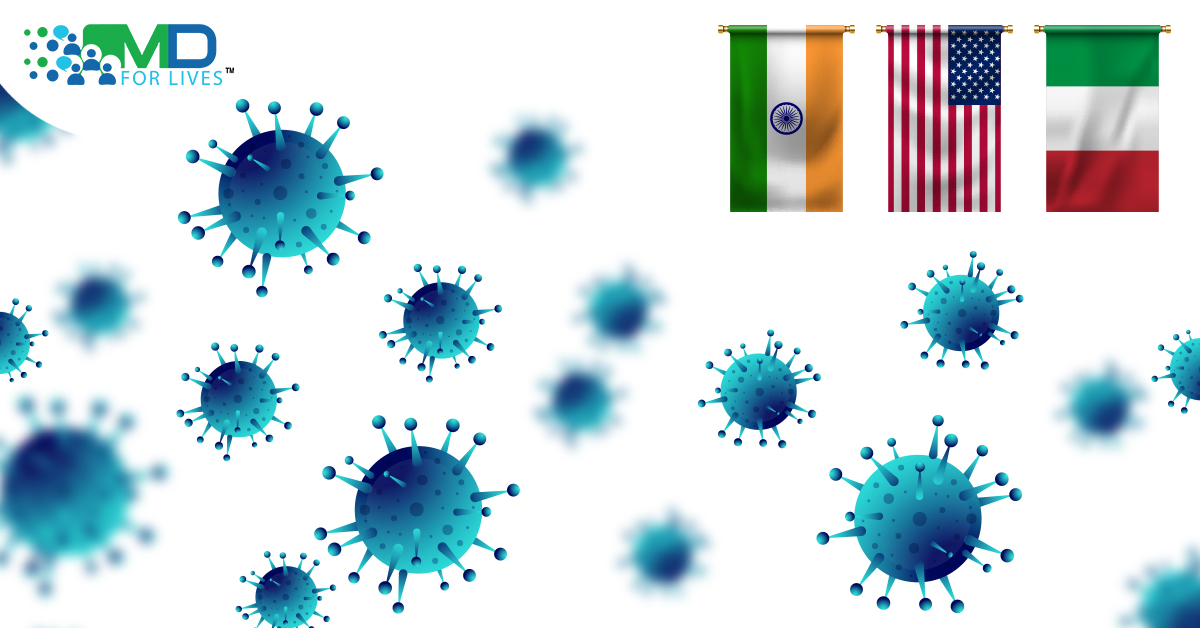The novel coronavirus (nCoV-19) or the severe acute respiratory syndrome coronavirus 2 (SARS-CoV-2) is a new public health crisis that the world has currently been challenged with. The virus is of zoonotic origin (originating in bats) and was first detected in the Hubei province of Wuhan, China in December 2019. Recently, more than 4,71,820 individuals have been infected with the disease whereas around 21,297 have lost their lives owing to the pandemic nature of the outbreak2. Italy, the United States (US), and India are few among the many countries which have been affected by nCoV-19. In this regard, the aim of the present article is to highlight the current scenario of the nCoV-19 pandemic and to focus on steps taken by the countries and pharma giants to curb the disease outbreak.
Since its first incident in Wuhan, the nCov-19 has rapidly been changing its foci from China to Europe followed by North America, the Middle East and the rest of Asia. This drastic shift in foci has been more evident since the last three weeks as more and more cases of infection are sprouting up all over the world. As a result, by March 16th the number of countries, states, or territories reported to have been infected with this disease was around 143. Based on these alarming levels of spread, severity, and inaction, WHO on March 11th, 2020, characterized nCoV-19 as a “pandemic” 3 outbreak.
Current Scenario of nCoV-19
Epidemic curves are often used to investigate the status of a disease outbreak during the occurrence of an infectious disease. From the day of its first occurrence, nCoV-19 has resulted in a sharp increase in its prevalence curve throughout the world4. This, in turn, has led to the straining of healthcare infrastructures, including hospitals and ICUs as evident from the incidence rate of countries as:
Italy5 – In Italy, more than 74,386 people have been affected by the disease, and about 7,503 have succumbed to the fatal effects of nCoV-19. Among those who have faced death, around 96% had the so-called ‘mild form’ of the disease whereas 8% had the serious to critical illness.
The US5,6 – The US witnessed its first-ever case of coronavirus disease (COVID-19) on January 21st, and since then, there has been an exponential growth in the incidence rate of the disease. Currently, the country has registered approximately 68,508 diagnosed cases of the disease. Furthermore, almost 990 patients have been reported to have fallen victim to the lethality of the disease.
India7 – The country has nearly 649 confirmed cases of the disease out of which 43 have recovered from the illness while 13 have fallen prey to it.
Strategies Adopted by Countries to Deal With COVID-19
Given the pandemic nature of the disease, the WHO’s Strategic and Technical Advisory Group for Infectious Hazards (STAG-IH) had laid down the following recommendations3 for its member countries to design and adopt strategies to deal with COVID-19:
- Countries should promptly and sturdily increase their preparedness, readiness, and response after assessing their regional risk and the transmission scenarios (4Cs)8.
- All countries should consider measures including case and contact findings along with containment to delay the surge in the number of patients infected with the disease. Besides, these measures should be coupled with raising public awareness about the disease and preparing health systems for a surge in the number of cases.
- For countries with a few or no cases of COVID-19, authorities should keep active surveillance on those infected and practice social distancing.
Thus, keeping in line with recommendations laid down by STAG-IH, various countries, including Italy, the US, and India, have formulated their respective strategies to combat COVID-19. The strategies were as follows:
Italy9 – After a massive disease outbreak, the Italian government on March 9th, declared the country as ‘red zone’ which meant that people had to stay at home except for essential work and emergencies. Additionally, authorities also barred people from public gatherings and free movement.
The US9,10 – Moreover, as more than 75% of the US become infected with the disease, the federal government on March 10th announced a “containment area” within a 1-mile radius of New Rochelle. Also, California banned all gatherings, which were to consist of more than 1,000 individuals.
India11 – In India, although the number of people affected by the disease is relatively low, its central government has taken various steps to restrain the spread of the virus. The various steps taken include suspending visas and quarantining all incoming travelers suspected of having contracted the disease.
The Way Forward12 – As the number of COVID-19 cases continues to rise, pharmaceutical companies across the world are trying their best to formulate pharmacotherapies that would not only cure the disease but also help in preventing its spread through vaccines. Some of the therapies which are in the research pipeline include:
Vaccines for Covid-19
- Applied DNA Sciences in collaboration with Takis Biotech has developed a DNA vaccine. Pre-clinical testing of the vaccine has been planned to start in the second quarter of 2020.
- Codagenix Inc along with the Serum Institute of India is in the process of evolving a live-attenuated vaccine for COVID-19 using viral deoptimization.
- Moderna Inc: The company’s mRNA vaccine is under phase I study in the US.
- Novavax has developed a recombinant nanoparticle vaccine. The company is currently testing the vaccine in preclinical models and its phase I testing is expected to begin in the late spring.
- Pfizer along with BioNTech are co-developing an mRNA-based vaccine candidate that is expected to enter clinical trial by the end of April.
Antivirals
- AbbVie along with the European and US authorities have collaborated to determine the antiviral efficacy and safety of lopinavir/ritonavir against COVID-1913.
- AIM ImmunoTech is establishing rintatolimod (a broad-spectrum antiviral agent) as earlier preclinical trials have shown beneficial results. Similar studies have been carried out by Gilead on remdesivir (another broad-spectrum antiviral agent) whereby two, Phase-III trials are underway to evaluate the safety and efficacy of the drug.
Immunotherapies and Other Investigational Therapies:
- Innovation Pharmaceuticals is developing brilacidin (a defensin-mimetic). The drug has already passed phase II trials for other indications.
- Regeneron is formulating a novel multi-antibody cocktail therapy that can be administered both prophylactically and as a therapy for the SARS-CoV-2 virus or as a treatment for those already infected. The drug is expected to enter clinical trials by early summer.
- Takeda is testing an anti-SARS-CoV-2 polyclonal hyperimmune globulin to treat high-risk individuals with COVID-19.
Conclusion
To date, COVID-19 has affected nearly 159 countries across six continents14. Further, there are no FDA-approved pharmacotherapies for either prevention or mitigation of the disease. In such a scenario, the only hope now is to learn from our previous experiences of the SARS epidemic in 2002 as COVID-19 is very similar to that of SARS-CoV.






